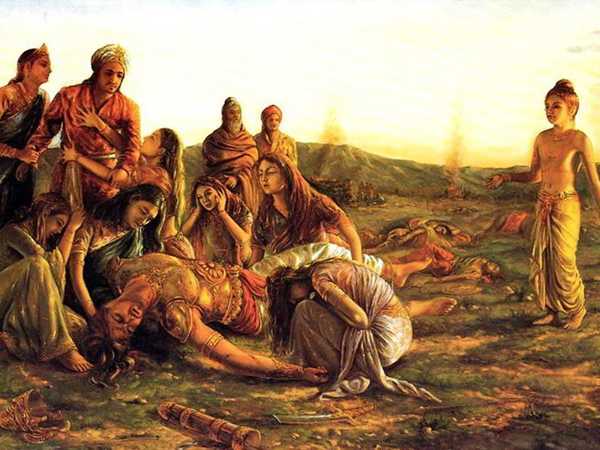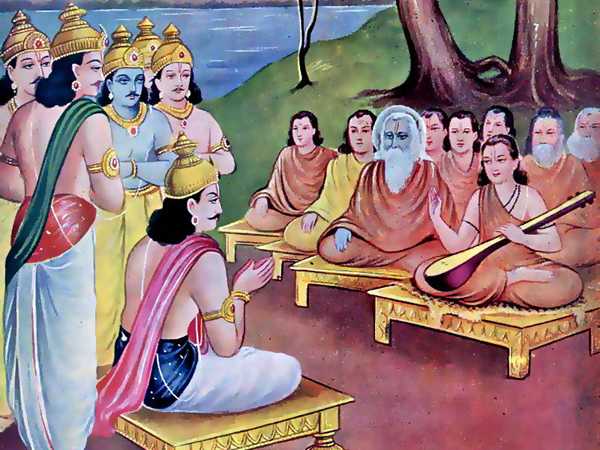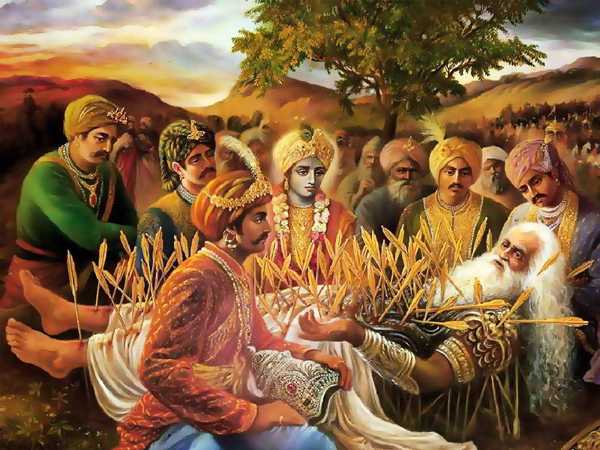Chapter 20

Dhritarashtra said,–“When the Sun rose, O Sanjaya, of my army led byBhishma and the Pandava army led by Bhima, which first cheerfullyapproached the other, desirous of fight? To which side were the Sun, theMoon and the wind hostile, and against whom did the beasts of prey utterinauspicious sounds? Who were those young men, the complexions of whosefaces were cheerful? Tell me all these truly and duly.”
Sanjaya said,–“Both armies, when arrayed, were equally joyful, O king.Both armies looked equally beautiful, assuming the aspect of blossomingwoods, and both armies were full of elephants, cars and horses. Botharmies were vast and terrible in aspect; and so also, O Bharata, none ofthem could bear the other. Both of them were arrayed for conquering thevery heavens, and both of them consisted of excellent persons. TheKauravas belonging to the Dhritarashtra party stood facing the west,while the Parthas stood facing the east, addrest for fight. The troops ofthe Kauravas looked like the army of the chief of the Danavas, while thatof the Pandavas looked like the army of the celestials. The wind began toblow from behind the Pandavas (against the face of the Dhartarashtras),and the beasts of prey began to yell against the Dhartarashtras. Theelephants belonging to thy sons could not bear the strong odour of thetemporal juice emitted by the huge elephants (of the Pandavas). AndDuryodhana rode on an elephant of the complexion of the lotus, with renttemples, graced with a golden Kaksha (on its back), and cased in anarmour of steel net-work. And he was in the very centre of the Kurus andwas adored by eulogists and bards. And a white umbrella of lunareffulgence was held over his head graced with a golden chain. Him Sakuni,the ruler of the Gandharas, followed with mountaineers of Gandhara placedall around. And the venerable Bhishma was at the head of all the troops,with a white umbrella held over his head, armed with bow and sword, witha white headgear, with a white banner (on his car), and with white steeds(yoked thereto), and altogether looking like a white mountain. InBhishma’s division were all the sons of Dhritarashtra, and also Sala whowas a countryman of the Valhikas, and also all those Kshatriyas calledAmvastas, and those called Sindhus, and those also that are calledSauviras, and the heroic dwellers of the country of the five rivers. Andon a golden car unto which were yoked red steeds, the high-souled Drona,bow in hand and with never-failing heart, the preceptor of almost all thekings, remained behind all the troops, protecting them like Indra. AndSaradwat’s son, that fighter in the van,[110] that high-souled and mightybowman, called also Gautama, conversant with all modes of warfare,accompanied by the Sakas, the Kiratas, the Yavanas, and the Pahlavas,took up his position at the northern point of the army. That large forcewhich was well protected by mighty car-warriors of the Vrishni and theBhoja races, as also by the warriors of Surashtra well-armed andwell-acquainted with the uses of weapons, and which was led byKritavarman, proceeded towards the south of the army. Ten thousand carsof the Samasaptakas who were created for either the death or the fame ofArjuna, and who, accomplished in arms, intended to follow Arjuna at hisheels[111] all went out as also the brave Trigartas. In thy army, OBharata, were a thousand elephants of the foremost fighting powers. Untoeach elephant was assigned a century of cars; unto each car, a hundredhorsemen; unto each horseman, ten bowmen; and unto each bowman tencombatants armed with sword and shield. Thus, O Bharata, were thydivisions arrayed by Bhishma. Thy generalissimo Bhishma, the son ofSantanu, as each day dawned, sometimes disposed thy troops in the humanarmy, sometimes in the celestial, sometimes in the Gandharva, andsometimes in the Asura. Thronged with a large number of Maharathas, androaring like the very ocean, the Dhartarashtra army, arrayed by Bhishma,stood facing the west for battle. Illimitable as thy army was, O ruler ofmen, it looked terrible; but the army of the Pandavas, although it wasnot such (in number), yet seemed to me to be very large and invinciblesince Kesava and Arjuna were its leader.”



